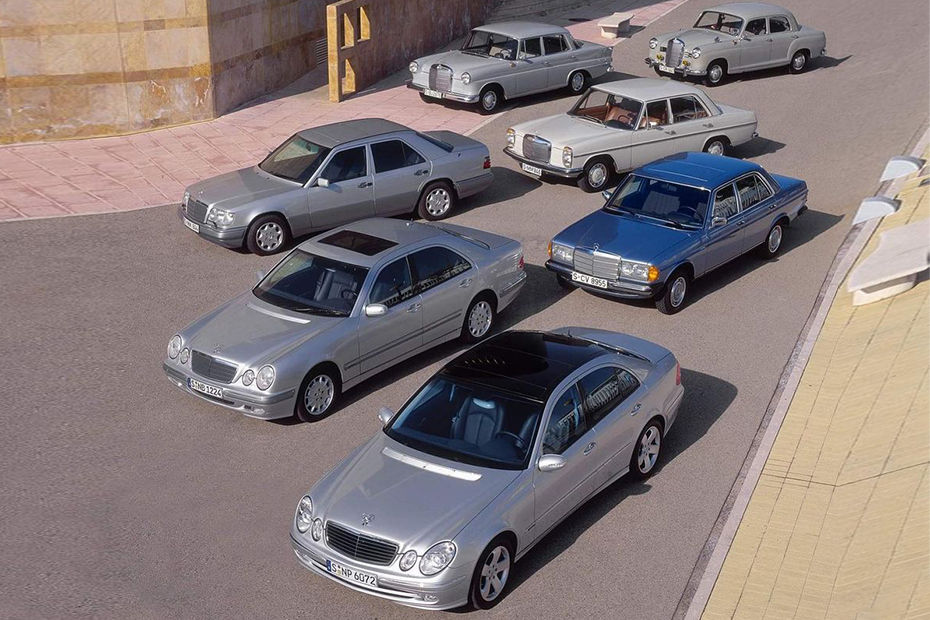A Look At How The Mercedes-Benz E-Class Has Evolved Over The Years
Modified On Apr 28, 2023 06:06 PM By Rohit
- Write a comment
With the 6th-gen E-Class being unveiled recently, we thought you might be interested in knowing how one of Mercedes-Benz’s most popular sedan has evolved over the years

One of the best-selling models in the Mercedes-Benz lineup globally is the E-Class sedan. The German luxury carmaker has just unveiled the sedan’s 6th-generation iteration, and has stated that it will be India-bound by mid-2024 as well. So, we decided to take a walk down the memory lane, and brief you up about how far the popular Merc sedan has come through its generations.
Where It All Began
Although Mercedes-Benz used to make models in the E-Class lineup well since the 1940s, it’s only from 1993 that it started using the “E-Class” moniker to denote the more premium models under this umbrella.

The very beginning of the E-Class was marked by the production of one of its predecessors soon after the Second World War. In 1926, two brands, namely, Daimler and Benz merged to form Daimler-Benz AG, the parent company of today’s Mercedes-Benz. Following this, it was only in 1947 that the E-Class was launched as the first post-war Mercedes-Benz passenger car.
Scenario Back Home

Mercedes-Benz was the first luxury carmaker to enter and start production in India in 1994 by tying up with Tata Motors (then referred to as “Telco”). Its portfolio began with the development of the model series 124 of the E-Class at Tata’s Pune facility and was then priced at about Rs 20 lakh (ex-showroom). Although there were a few hiccups initially for Mercedes-Benz in our market, it did manage to gain a strong hold in the Indian luxury car space soon. Following that, there was no looking back for neither the carmaker nor the sedan nameplate in our market.
Also Read: Here’s Why Mercedes-Benz Accounts For Nearly 30 Percent Of Total Vehicles Registered In Albania
Model Series 123: The One To Popularise The Sedan Lineup

It was the model series 123 that really kicked things off for the E-Class in 1976. In its decade-long production, Mercedes-Benz produced around 2.7 million or 27 lakh units of the 123 series, the most for any generation under the “E-Class” nomenclature. It became a popular name among buyers in no time, so much so that the cars produced in the first year were sold out soon after the launch. Not only that, some customers even had to wait up to a year to drive their sedans home.

The model series 123 was also the first model from the carmaker to be offered in new body styles such as an estate (1977), a coupe and a long-wheelbase limousine (either in a 7- or an 8-seater configuration). It was available with as many as nine engine options, with a maximum output of 177PS.

Mercedes-Benz used to provide it with cruise control (as an optional extra), ABS, and even a driver-side airbag – a first in its vehicle category. From 1982, it even got power-assisted steering as standard.
Model Series 124: The Real Introducer Of “E-Class” Nameplate And The Most Famous Classic “E” In India


The carmaker manufactured the model series 124 from 1984 to 1997, which essentially sported the “E-Class” nametag beginning in 1993. It was also offered in four body styles – saloons (including a long-wheelbase version), coupe, estate and a cabriolet – the last one being a first for the sedan nameplate.


Upon launch, the model series 124 was offered with a range of powertrains as well like its predecessor, with an output as high as 190PS. That was further amplified by the introduction of the 500 E which had the first 8-cylinder engine in the sedan’s history, having 326 horses under the hood. Then there was the first high-performance product in the E-Class lineup under the Mercedes-Benz and AMG collaboration in 1993, which gave birth to the E 60 AMG (381PS).


The model series 124 didn’t fall short on technology either as it came with a 3-stage electronic dynamic handling control system, an automatic locking differential (ASD), acceleration skid control (ASR), and the 4MATIC 4-wheel-drive system. Mercedes-Benz offered it with ABS as standard, followed by driver-side airbag and central locking.


From 1993, it gained the “E-Class” moniker, and was placed in the revised sedan lineup inclusive of the new C-Class and S-Class models. Its total sales even broke the cumulative figure of 27 lakh of its already successful predecessor by nearly 50,000 units.
Also Read: Mercedes-Benz Unveils The First Ever Electric Maybach In The Form Of EQS 680
Model Series 210: A Fresh Take On Design

In 1995, the carmaker introduced the second-gen E-Class, which got a four-eyed look for the first time thanks to the elliptical twin headlights. Its estate version was launched a year later, featuring an additional bench seat mounted facing backwards and it got 3-point seat belts, making it a seven seater. Mercedes-Benz, however, didn’t offer this generation of the sedan in the coupe or cabriolet avatar.

It was available with a range of petrol and diesel engine options, including the AMG variants as well, producing up to 354PS in its performance-oriented versions, and came with a 5-speed automatic gearbox. The 210 series got various technological updates as well including the introduction of common rail direct injection and V-engine model series with three valves per cylinder.

With the 210 series, Mercedes-Benz introduced a new variant lineup for the E-Class – Classic, Elegance, Avantgarde and AMG – having cosmetic and feature differences, as we are familiar with today. A whole lot of new equipment was provided with this generation including xenon headlights with automatic range adjustment, 16-inch alloy wheels, APS navigation system, and heated and ventilated seats (optional extra). Even its safety net was boosted with the inclusion of electronic stability program, traction control, side airbags, and rain sensor.
Model Series 211: A More Modern 210

Mercedes-Benz launched the third-generation E-Class in 2002 while retaining the twin headlights look. The 3rd-gen E-Class was also available in both saloon and estate versions.

It came in the same trim lines as its preceding generation model but with more convenience and safety equipment. The 3rd-gen E-Class was the first car globally to get adaptive headlights, which also came as an optional extra with five different lighting functions. Other new features on offer included automatic tyre pressure monitoring system, automatic climate control, radio, multiple airbags, and automatic child seat recognition.
Like its previous iterations, the 3rd-gen E-Class came with a buffet of powertrain options (including 6- and 8-cylinder petrol engines). In 2002, the top-of-the-range E 55 AMG got 476PS of power under the hood. Mercedes-Benz then introduced the E 63 AMG – the most powerful E-Class ever – in 2006. It was equipped with a 6.2-litre V8 engine making 514PS, mated to a 7-speed DCT automatic.
Also Read: 10 Warning Signs On Your Car Dashboard That You Should Know
Model Series 212: “Twin Headlights” Design With A Twist

While Mercedes-Benz carried forward the twin headlight design for the 4th-gen E-Class in 2009, the carmaker did tweak it to freshen things up. The 4th-gen model looked sharper and got a chrome outline for its grille. The carmaker offered it in all four body styles: saloon, estate, coupe and cabriolet. It helped the 2-door model bag the recognition of being the world’s most aerodynamically efficient production car, while the saloon became the most aerodynamically efficient model in its category.

Mercedes-Benz provided the 4th-gen E-Class with a variety of engine options as well, including a top-of-the-line E 63 AMG version (525PS) introduced in 2009. The carmaker had made this generation of the E-Class more fuel efficient by reducing fuel consumption by up to 23 percent and also offered it with multiple technology features to save on fuel, including idle-engine start/stop. In 2011, Mercedes-Benz launched its first diesel-hybrid car in the form of the E 300 Hybrid and E 400 Hybrid. Following the update in 2013, the 4th-gen E-Class also got an E 63 AMG S 4MATIC version having 585PS of power with an all-wheel drivetrain. The 4th-gen E-Class was the first car in the world to get a 9-speed automatic transmission option.

Features that were added to the equipment list over its predecessor include driver drowsiness alert (standard fitment), high-beam assist, blind-spot assist, autonomous emergency braking, and lane keeping assist (as optional extras). Its infotainment software allowed universal connectivity, allowing unlimited use of two Mercedes-Benz apps – “Mercedes-Benz Radio” and “Service Mercedes-Benz” – while driving.
Model Series 213: The Best One Yet

In 2016, the carmaker brought in the 5th-gen E-Class, once again in multiple body types including a coupe and cabriolet. It is equipped with the best tech and safety features yet, and is the one available in Indian showrooms currently (of course in the facelifted avatar introduced in 2021) priced in the range of Rs 75 lakh to Rs 88 lakh (ex-showroom Delhi). In 2010, the carmaker introduced a long-wheelbase version of the sedan for the Chinese market. Apart from China, India is the only country to get the long-wheelbase E-Class, and the only right-hand drive market for the long-wheelbase version of the saloon.

Mercedes-Benz has provided it with cloud connectivity features to communicate with other cars, NFC as a digital key, remote parking assist, speed limit assist, brake assist, and lane change assist. The sedan also comes with dual 12.3-inch displays (one for infotainment and the other for instrumentation), 64-colour ambient lighting, steering-mounted touch-based controls, and LED headlights.
Among the plethora of engine options available, Mercedes-Benz also introduced a plug-in hybrid version of the saloon. There obviously are the AMG iterations too having max power of 612PS while retaining the 9-speed AT gearbox.
Model Series 214: The Most Futuristic E-Class Ever

Fast forward to April 2023, and the carmaker has just uncovered the 6th-generation E-Class (model series 214) with a futuristic design language and a bucket load of features. The new E-Class has a blend of Maybach and 7th-gen S-Class’s design inside and out, while being one of the few models in the carmaker’s lineup to feature an internal combustion engine (ICE).

The sixth-gen E-Class has an evolutionary design language featuring curvy clusters for its LED headlights and tri-arrow motifs in its LED taillights. While it has a minimalistic appeal on the inside, the showstopper in the cabin is the dual-display setup (consisting of a 14.4-inch touchscreen system and a 12.3-inch digital driver’s display). There’s also a passenger-side screen that is available as an optional extra. It even gets selfie and video camera apps, four-zone climate control, and advanced driver assistance systems (ADAS) features.

Mercedes-Benz will offer the new E-Class with both petrol and diesel engine options, including a plug-in hybrid version too. The sedan also gets an electric boost option which now adds up to 23PS. The 6th-gen E-Class also features rear-wheel steering that’s passed on from the flagship sedan as part of the Technology Package that also consists of air suspension.
Which version of the E-Class is your most favourite and why? Drop your answer in the comments.
Read More on : Mercedes-Benz E-Class diesel
5 out of 5 found this helpful













